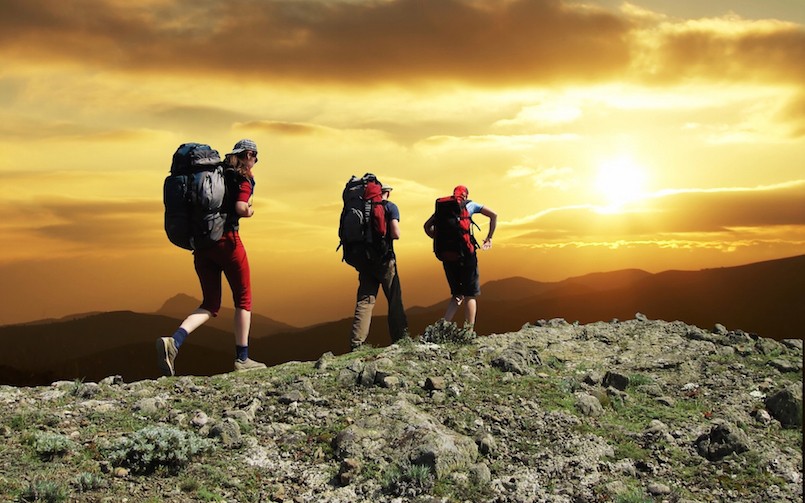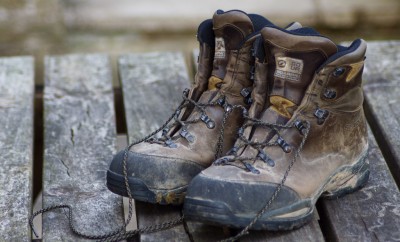Gear
Types Of Hiking Boots And Hiking Shoes

Image: Argyruntum
There are many types of hiking boots and hiking shoes, and the choice can be bewildering. While there are some kinds of hiking footwear that will not fit neatly into any category, I will discuss hiking footwear in terms of four categories, based on the general kind of hiking for which they work best.
Article Source: http://EzineArticles.com/1197753
- Hiking shoes and sandals. For short walks in the outdoors, for knocking around in camp, and for easy interludes in an otherwise serious hike.
- Day-hiking boots. For moderate hiking, such as day hikes or short hikes in rough country.
- Backpacking boots. For multi-day backpacking trips.
- Mountaineering boots. For the most serious hiking, mountain climbing, and ice climbing.
As you move up the scale of categories, you also move up in price. That means you have to give more serious thought and do more careful shopping the higher up the scale you look. But before you begin your serious shopping, get a handle on what types of hiking boots are available so you will be sure you are looking for the right kind.
Don’t be scared off by the prices, and don’t make the mistake of assuming that you don’t need special-purpose hiking boots. You probably don’t need $200 mountaineering boots, but that doesn’t mean you should try a twelve-mile day hike in your tennis shoes, either. In this article, you will learn how to decide which general type of hiking boots are right for what you want to do. Then you’ll be prepared to look deeper into exactly what you need.
Hiking Shoes and Sandals
Hiking shoes can be multi-purpose footwear. If you are new to hiking, and planning only short hikes on well-maintained trails, you might already have suitable footwear. Cross trainers or any reasonably sturdy sneaker may be suitable for light hiking.
Shoes expressly designed for trail running and light hiking typically rise a little higher than conventional sneakers, and they usually have a “scree collar” (a collar of padding around the ankle to keep pebbles out). They are usually not waterproof, though they may be somewhat “water resistant,” and the tread is not very aggressive.
Hiking shoes are suitable for short hikes on reasonably dry, reasonably smooth trails where you will not be carrying much weight. If you will be crossing streams, climbing steep slopes, walking on snow and ice, or carrying more than about twenty pounds of gear, you should probably look into day-hiking boots or backpacking boots.
Hiking sandals are a special class of hiking footwear. When you consider the four main purposes of hiking shoes – warmth, protection, traction, and keeping dry – sandals might seem like a joke. But think again.
Obviously, you’re not hiking in winter in hiking sandals, so keeping your feet warm is just not a consideration that hiking sandals address. Sandals do protect the soles of your feet from rough surfaces and sharp objects, but they can’t protect the sides of your feet from rocks and brush. They also provide good traction.
But what about keeping your feet dry? Don’t laugh! No, sandals will not keep the water out as you wade across a stream, but neither will they keep the water in when you step out of the stream. Many hikers carry sandals in their backpacks and switch to them whenever they cross a stream that they know is going to overtop their hiking boots.
If all you are going to do is short hikes on relatively clear, level trails in warm weather, sandals are worth at least a little consideration. More importantly, if you want a pair of hiking shoes to switch out in the middle of a long, serious hike, hiking sandals may well be worth the space they take up in your backpack.
Day-Hiking Boots
Day-hiking boots are purpose-designed for hiking. If you are planning to do any moderate hiking, such as all-day hikes or short hikes on rugged trails, you will need to give some serious thought to your footwear.
Day-hiking boots typically rise just above the ankle, and they always have a padded “scree collar.” They usually have a fairly stiff fiberglass shank to reinforce the sole and arch supports. The tongue is partially attached, sometimes fully attached, to provide waterproofing.
Day-hiking boots nearly always have hooks for the laces on the upper part of the boot. Some have eyelets all the way to the top, but these are hard to keep properly tightened.
Beware of imitations! The fashion industry has caught on to the style of hiking boots, and you will find many shoes that look like hiking boots, but are better suited to hanging out at Starbucks than to hiking the backwoods. Look closely, and you can tell the real hiking boots from the wannabes:
- Scree collar
- Stiff shank
- Attached or partially attached tongue
- Genuinely aggressive tread
None of these features show when you’re just looking cool, so the imitation hiking boots don’t have them.
Backpacking Boots
Backpacking boots are designed for long wear under fairly harsh conditions. If you are planning to do a lot of hiking, especially multi-day backpacking trips or all-day hikes on rough trails, you will need backpacking boots. And don’t be put off by the prices: A hundred-dollar pair of boots that lasts five years is cheaper than buying a forty-dollar pair every year. And more comfortable, too.
Backpacking boots usually rise well above the ankle. Very high-rise boots, like military-style “combat boots,” may not have a padded “scree collar,” but lower-rise boots will have one. They have a rigid shank, which may be fiberglass or steel, to provide stiffness and arch support. The tongue may be partially attached on high-rise boots, or fully attached on lower boots. Backpacking boots always have a very aggressive tread design.
Many backpacking boots have eyelets for the laces all the way up. This makes the boots harder to put on and take off. It also makes the laces more difficult to adjust than if they had hooks, but the eyelets are less prone to catching on brush or getting bent closed when you bash your leg against a boulder. D-rings, used on the upper parts of some hiking boots, are a good compromise. They are less prone to damage than hooks, but more easily adjustable than eyelets.
There are heavy-duty boots out there that are not suitable for hiking. Work boots can be very similar to hiking boots in every detail except the tread. When choosing backpacking boots, make sure the tread is designed for the trail and not for the workshop.
Mountaineering Boots
Mountaineering boots are specially designed for serious expeditions in primitive and rugged conditions. The term “mountaineering boots” generally also includes such specialized footwear as ice-climbing boots.
I’ll be perfectly honest here (habit of mine): I have no personal experience with mountaineering boots, nor with the conditions that require them. So I don’t have much to tell you about them other than that they exist and that, depending on your requirements, they may be what you need. When you are ready to take a good look at mountaineering boots, I can only advise you to look for suitable advice.
Mountaineering boots are generally completely rigid, made of thick, heavy leather or molded plastic. They are quite heavy, and difficult to walk in under most normal conditions.
Don’t be oversold. If you are looking for backpacking boots, you don’t need special-purpose mountaineering boots. This is one case where buying more hiking boot than you need can actually be a bad thing. Mountaineering boots are what you want for climbing Mount Everest, but not for hiking in the typical National Park.
Conclusion
Now you know now to recognize the four main types of hiking boots. That will help you in your search. Choose the type of boot that is right for the type of hiking you are planning to do, then go do it!
Chuck Bonner is a lifelong hiker and amateur naturalist, and webmaster of http://www.HikingWithChuck.com. For more information about hiking boots and other hiking equipment based on many years on the trail, visit [http://www.hikingwithchuck.com/Gear/HikingGear.htm].
Article Source: http://EzineArticles.com/?expert=Chuck_Bonner




0 comments